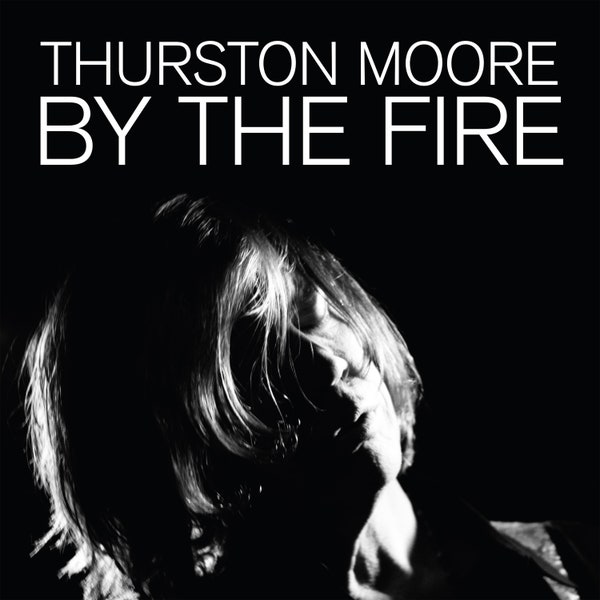A track-by-track review of Thurston Moore new 2020 album By the Fire

review by Jordan Lamash
Release Date: Sept. 25, 2020
Length: 1h 22min
Genre: Experimental Rock
Label: Daydream Library
Few bands have achieved a flawless discography – where every album they release presents innovative and captivating ideas.
To me, Sonic Youth is one of those bands. From pioneering the noise rock subgenre in the early 80s, to dabbling in hip-hop and ambient during the 90s and 2000s, Sonic Youth were always hard to pin down.
You never knew where they were going next – which is why their 2011 breakup absolutely blindsided fans after a three decade run. At a time when modern rock felt very cookie-cutter, Sonic Youth never conformed to what the radio wanted. As such, their departure from the music world left a sizable gap that hasn’t been quite filled since.
Post breakup, most of Sonic Youth’s members have gone on to do session work, form new bands, or record one-off collaborations. In contrast, guitarist and primary songwriter Thurston Moore has managed to carve out a successful solo career.
Much like his work with Sonic Youth, Moore’s own albums have flip-flopped between styles – ranging from the vulnerable heartbreak of 2011’s acoustic Demolished Thoughts to last year’s Spirit Counsel, an instrumental epic composed of only three improvisations.
With every new album, it’s interesting to see what sounds will catch Moore’s ear and who he’ll decide to work with. This time around, we get two Moore regulars – James Sedwards (guitar) and Jon Leidecker (electronics) – as well as Deb Googe (bass) of My Bloody Valentine fame. Most notably, there are two drummers performing on the record – past collaborator Jem Doulton and former Sonic Youth band mate Steve Shelley. So, with all this being said, what does Moore give us on By the Fire?
Track 1 – “Hashish”
The album opens with the quick five-minute desert rocker, “Hashish”. The track kicks off with a dissonant guitar pattern that sounds like it came straight out of southern California – very reminiscent of Queens of the Stone Age. After a handful of measures, the drums and bass finally kick in to elevate the song to the next level.
On this track, Moore is unashamedly staying in his comfort zone. The contrast between softer guitar melodies and driving bass rhythms made the song feel like a leftover from Sonic Youth’s last two records. While the musicianship is definitely there, I couldn’t help but wonder if I would like “Hashish” as much if I didn’t have a huge bias going in. It entertained me enough to keep listening, but begged me to ask the question, “Will Moore do anything new on this album?”
Track 2 – “Cantaloupe”
“Cantaloupe” is a short and sweet head banger that gets right to the point with a chunky, heavy metal guitar riff. On first listen, it reminded me a lot of Weezer’s “Hash Pipe.” Lyrically, Moore is as absurd as always. Take the chorus, for example: “We’re pulsing blue, blue to orange / Dripping fire music down your back / Floating up through your skin / White gardenias in your eyes.” While I didn’t grasp the full meaning of the lyrics, I didn’t mind this as “Cantaloupe” made up for it with its explosive instrumentation.
Speaking of which, I absolutely adore the bluesy guitar solo that comes in halfway through. There’s some obvious Black Sabbath worship going on, but I’ll let it slide. All in all, Moore improves on the album’s opener by taking the prototypical stoner metal song and making it his own.
Track 3 – “Breath”
On the third song, “Breath”, Moore deviates from the conventional structure of the album’s first two cuts and delivers an eleven-minute psychedelic labyrinth. The track begins with a meditative guitar lick that’s aided by some light percussion and atmospheric bass. If I didn’t know any better, I’d think I was listening to a softer moment from Pink Floyd’s Dark Side of the Moon.
At the two-minute mark, the song takes a 180⁰ turn and builds up a brutal crescendo of arpeggiating guitars and bustling hi-hats. Right before the apex, there’s an abrupt transition into a light-hearted folk-rock jam.
I would have preferred if “Breath” continued building on the primal aggression of its first movement, as the track felt like two separate ideas to me. Another thing to nitpick is that the song repeats at the seven minute mark, meaning you will hear the same crescendo and folk-rock groove again. The same emotional effect could’ve been achieved if “Breath” was trimmed by about half.
Track 4 – “Siren”
“Siren” quickly became my favourite song on By the Fire by a long shot.
At twelve minutes and change, it’s one of the album’s longest songs, but it doesn’t feel like it. The first four minutes consist of a gorgeous tune that feels like summer to the ears. When I close my eyes, the first thing I imagine is the flowers blooming. A minute later, the track takes a dark turn with a solemn, slowed down melody. Although there are no vocals yet, the weeping and echoing guitars do an exceptional job of conveying desperation in the music. The drums also hold this section down by playing a repetitive, yet hypnotic rhythm while the other musicians are free to wander.
At the six-minute mark, the song completely implodes and gives way to a transition of distorted guitars and crashing cymbals, before returning to the same elegant melody from the song’s opening. When the vocals come in, Moore opts to use a laid back delivery that resembles Chris Martin from Coldplay. It suits the lyrics, as he uses pretty metaphors about the ocean and the beach to sing about an unrequited love.
As a whole, the seamless transitions between movements, as well as the lyrical focal point, help create a spectacular piece of music in “Siren.”
Track 5 – “Calligraphy”
Coming at the mid-point of the album, “Calligraphy” gives the listener a much needed break. The song completely sheds all the instrumental layering we’ve heard so far on By the Fire, stripping it back to Moore on lead guitar and Sedwards on rhythm. With no drums to be found, I was really able to focus on the textures and effects coming from their playing. Instrumentally, “Calligraphy” reminds me of an acoustic grunge song from the 90s – with elements of blues, country, and southern rock in the guitar work. I particularly enjoyed the mixing, too, as you can hear the ruggedness of Moore’s hands sliding up and down the fret board. While “Calligraphy” is a fine song with no real flaws, I feel that it doesn’t fit the darkened sound of By the Fire, and could have been better saved for a brighter album.
Track 6 – “Locomotives”
At a staggering seventeen minutes, “Locomotives” is fortunately the most dynamic song on By the Fire. The first five minutes are anchored by a tribal rhythm on the drums, in addition to some whaling guitars in the background. The combination of the two gave me a strong industrial vibe, which suits the song’s title without a doubt.
After this passage, the drums disappear and the guitars layer themselves on top of each other – creating a cacophonous noise comparable to a swarm of bees. The instrumentation then becomes much lighter with a twinkly guitar melody and a standard 4/4 drum beat, setting the stage for Moore’s vocals.
Like a sort of prophet, Moore chants his esoteric demands to the listener: “We take nothing, only liberties / And just one photo, if you please.” Immediately following the last verse, we get bombarded with a series of piercing guitar strums that I’ve come to appreciate with multiple listens.
Afterwards, the twinkly guitar melody from earlier returns and develops into a full on jam session. Out of nowhere, Sedwards comes in with the only other guitar solo on the album – this time inspired more by classic rock à la Eric Clapton. The solo was the perfect cherry on top to end “Locomotives”, as it gave a clear voice to the foundation that the band was laying down right before.
Track 7 – “Dreamers Work”
“Dreamers Work” serves as another well-deserved break after the enormity of “Locomotives”. For this interlude, Moore is solely accompanied by Googe on bass. The title of the track fits perfectly as the instrumental is very sleepy, but luckily not in a way that loses your attention. Once again, Moore lets the guitars do most of the talking – filling up the first half of the track with an introspective folk melody.
When he finally starts singing, Moore takes a very subdued approach, almost like he’s just trying to talk to the listener. One standout line I liked was: “A dreamer’s work, decades through / Held their dream up and made it true / Year after year, a natural force / Their attitudes or an open door.” While I enjoyed the song overall, I don’t think I would return to “Dreamers Work” unless it was being played in the context of the album. As an individual track, I much prefer the bigger payoff of By the Fire’s longer compositions.
Track 8 – “They Believe in Love [When They Look At You]”
“They Believe in Love” is the perfect blend of Moore’s experimental side cut down to a more palatable length – only eight minutes!
The track jumps right into a super abrasive groove, led by the bass and drums. Around two minutes in, Moore begins to play a despondent picked melody, conveying an emergency of some sort to the listener. The drums and bass help emphasize this feeling by kicking it into high gear alongside him. Googe’s playing from here on out is her best on the entire album, as is the drumming, which steals the show with a complex military march.
Moore’s songwriting is also his most straightforward on the record, featuring my favourite lyrics of his: “They believe in love / When they look at you / It’s a profound wonder / A revolution, a truth.” As Moore finishes singing, the song takes it up a notch for the final home stretch. While the rest of the band drifts in and out of time, Googe keeps the “real” rhythm with surgical precision – providing the end of the track with a hypnotic auditory illusion.
Track 9 – “Venus”
“Venus”, the only instrumental on By the Fire, is also the album’s most challenging listen. The song sounds completely improvised on first listen, relying mainly on atmosphere instead of structure.
The first half features a swarming buildup of fuzzed out guitars, holding notes for as long as 10 seconds at a time before releasing the listener from their peril. The cymbals are all over the place, switching from the crash to the ride to the hi-hats in a matter of milliseconds. Underneath this discord is the only sense of grounding we get, a series of pulsating quarter notes on the kick drum that recur every two measures.
Near the halfway mark, “Venus” foregoes any notion of rhythm it’s developed – falling apart into a droning swamp of feedback and noise. From here, the song adopts an ambient soundscape, letting the listener decompress and reflect on what they’ve just heard. I would have preferred if By the Fire started with all 14 minutes of “Venus”, as it would have provided the album with a more provocative start than “Hashish” and “Cantaloupe”, which I found to be a little too accessible.
Overall, By the Fire is an album that, while technically masterful, suffers from major cohesion issues. There are no real problems to be found on any one song. However, it’s the mix of varying styles that holds it back from being a truly great piece of work.
While Moore has been notorious at switching genres throughout his career, he usually focuses his albums to one core sound. Here, we get the experimental elements of Spirit Counsel and Sonic Youth’s SYR series (“Siren”, “Locomotives”, “Venus”) mixed with the pop-rock of albums like Goo! and Dirty (“Hashish”, “Cantaloupe”). On top of this, there are also a few folk and blues detours, that while well-placed, don’t really command a second listen unless listening to the album front to back (“Calligraphy”, “Dreamers Work”).
It all adds up to an enjoyable, yet disjointed, listen.
For me, I have always been a bigger fan of Moore’s longer, more challenging compositions – which would have stood out better if By the Fire was cut down to half its length. It’s the curious case where an album gets better by omission, rather than addition.
If I saw By the Fire in a record store, I wouldn’t hesitate to pick it up. Fans of Moore’s solo work will no doubt love what he’s putting down here, and that includes me. I would also make the case that the album’s mix of styles could actually be beneficial for those trying to get into Sonic Youth or its members. Although, for those already familiar with Moore’s work, a deeper dive into one individual sound would have been more fulfilling in the end.
Album on
Apple Music
Spotify
This review was modified on November 12: it was Sedwards who played the guitar solo on ‘Locomotives’, not Moore, as originally stated.



